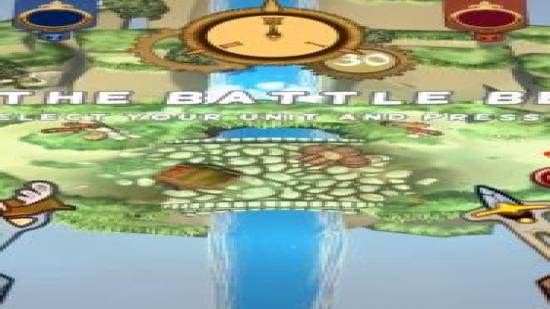Hidden away in one corner of the Eurogamer Expo’s indie arcade is one of the smartest games of the show, a game which has no fanfare and no budget, but if you’re heading to the expo, it’s absolutely worth a play, and if you’re not, you should keep it on your watchlist. Here’s why. And a trailer. Woo!
IsoChronous is a two player game with a top-down perspective, a cartoon fantasy theme and a devious concept. Both players have a king in a tower that they must defend, while sending units out from the tower to attack their opponent. Sure, it sounds like tower defense game, and I thought that’s what it was, but I was wrong.
You select just one unit from a list, send out to attack and then take direct control of it. You find yourself fighting the unit your rival has chosen, trying to sneak past them so that you can land a few hits on their tower and, simultaneously, trying to head them off and keep your own tower safe. Sure, it sounds like an action game, and I thought that’s what it was, but I was wrong.
The first time I did this, in the first round of the game, I used an archer to effortlessly slay the swordsman sent against me, before then shooting the tower to pieces. My opponent’s soldier became a ghost and wandered the map, swinging wildly and ineffectively at my own tower. The thirty second round ended and the enemy king lay dead. Job done.
Then the clock wound back. Everything happened in reverse.
When the new round began, I had to select a different unit from the list and do it all again. I discovered I couldn’t select the archer I picked because… oh my God. He was striding out of my tower already, repeating those same moves I had executed last round. And then he wasn’t, because my opponent killed him with the new unit he’d picked. And then the enemy tower was undamaged, the king still alive and…
Oh no, that enemy swordsman was still standing, because my archer hadn’t had a chance to stick him. He was slashing and stabbing his way through my defenses the way the ghost had in the previous round. While I was confused, the second unit I picked was cut down and my tower was smashed to pieces.
Then the clock wound back. Everything happened in reverse.
Okay, I thought, I’m in trouble. I’m out of my depth and I’m short another unit. I plumped for a wizard this time, and tried my best to use the wizard to keep my archer alive, so that he could kill the swordsman and then shoot the tower, but now I had to deal with the two units my enemy had previously used, along with a healer he was now using to revive units I was desperately trying to destroy.
IsoChronous builds up these thirty-second rounds on top of each other, each one replaying itself in the same way, chronolayer upon chronolayer, and while the units you previously controlled are compelled to repeat the same motions over and over, you can still use your current unit to affect whether they live or die. Since slain can still be controlled in their ghost form, there’s nothing to stop you sending them off to attack something that they can’t touch this round, but might be able to kill in the next. Then, of course, you get possibility upon possibility, where units may or may not kill other units who revive other units who bring down the tower. Or don’t.
That’s the game.
If that was the end of it, I’d be impressed. I’d say it’s a bit of a shame that IsoChronous needs two players at the same PC using gamepads to play, because PC users don’t tend to sit around the same machine, but developers team-iso say there’s so much more in the works, but they have to get back to their homework first.
It turns out that team-iso are five Spanish students studying in different universities around Europe who, somehow, have managed to make this incredibly smart and incredibly polished prototype in just two months. Two months. The game I just played, they tell me, might be suitable as a demo for what their main project is, where they want to build a host of different levels, add in online play and create a single-player campaign. The latter might well be the biggest challenge, as coding an AI that can keep up with the chess-like possibilities presented by these rounds that layer upon each other won’t be easy.
Then again, if they can create a prototype this impressive in such a short time, I’m sure they’re up to the challenge. In the meantime, team-iso are bunking off university to come to London and show off their game. They seem surprised that people are asking when and how they can buy IsoChronous, but I’m not, and I think that if you’re headed to the expo this weekend, you should absolutely give this a play while you can.
